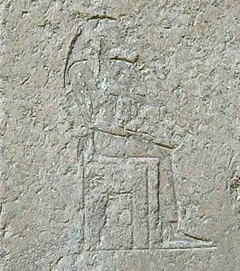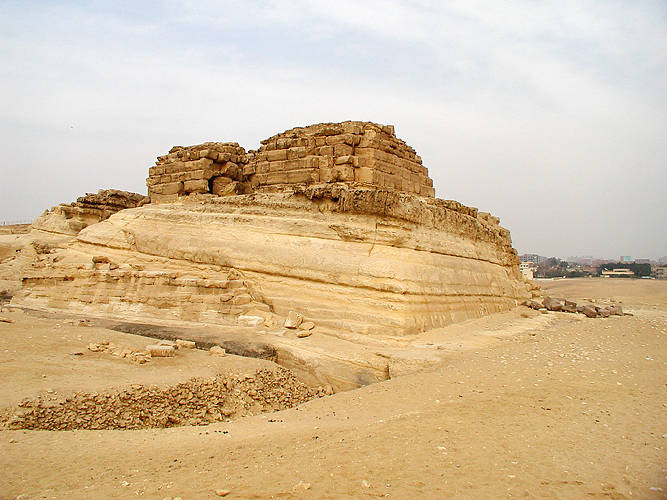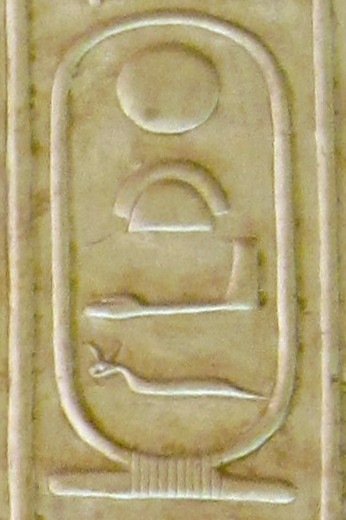|
Menkaure
Menkaure (also Menkaura, Egyptian transliteration ''mn-k3w-Rˁ''), was an ancient Egyptian king (pharaoh) of the fourth dynasty during the Old Kingdom, who is well known under his Hellenized names Mykerinos ( gr, Μυκερῖνος) (by Herodotus) and Menkheres ( gr, Μεγχέρης) (by Manetho). According to Manetho, he was the throne successor of king Bikheris, but according to archaeological evidence, he was almost certainly the successor of Khafre. Africanus (from Syncellus) reports as rulers of the fourth dynasty Sôris, Suphis I, Suphis II, Mencherês, Ratoisês, Bicheris, Sebercherês, and Thamphthis in this order. Menkaure became famous for his tomb, the Pyramid of Menkaure, at Giza and his statue triads, showing the king together with his wives Rekhetre and Khamerernebty and with various deities. Family Menkaure was the son of Khafre and the grandson of Khufu. A flint knife found in the mortuary temple of Menkaure mentioned a king's mother Khamerernebty I, sugges ... [...More Info...] [...Related Items...] OR: [Wikipedia] [Google] [Baidu] |
Menkaura
Menkaure (also Menkaura, Egyptian transliteration ''mn-k3w-Rˁ''), was an ancient Egyptian king (pharaoh) of the fourth dynasty during the Old Kingdom, who is well known under his Hellenized names Mykerinos ( gr, Μυκερῖνος) (by Herodotus) and Menkheres ( gr, Μεγχέρης) (by Manetho). According to Manetho, he was the throne successor of king Bikheris, but according to archaeological evidence, he was almost certainly the successor of Khafre. Africanus (from Syncellus) reports as rulers of the fourth dynasty Sôris, Suphis I, Suphis II, Mencherês, Ratoisês, Bicheris, Sebercherês, and Thamphthis in this order. Menkaure became famous for his tomb, the Pyramid of Menkaure, at Giza and his statue triads, showing the king together with his wives Rekhetre and Khamerernebty and with various deities. Family Menkaure was the son of Khafre and the grandson of Khufu. A flint knife found in the mortuary temple of Menkaure mentioned a king's mother Khamerernebty I, suggesti ... [...More Info...] [...Related Items...] OR: [Wikipedia] [Google] [Baidu] |
Shepseskaf
Shepseskaf (meaning "His Ka is noble") was a pharaoh of ancient Egypt, the sixth and probably last ruler of the fourth dynasty during the Old Kingdom period. He reigned most probably for four but possibly up to seven years in the late 26th to mid-25th century BC. Shepseskaf's relation to his predecessor Menkaure is not entirely certain; he might have been his son or possibly his brother. The identity of his mother is highly uncertain as she could have been one of Menkaure's consorts or queen Khentkaus I or Neferhetepes. Similarly, Shepseskaf's relation to his probable successor on the throne, Userkaf, is not known although in the absence of clear indication of strife at the transition between the fourth and fifth dynasties, Userkaf could well have been his son or his brother. If Shepseskaf was succeeded directly by Userkaf rather than by Thampthis as claimed by some historical sources, then his death marks the end of the fourth dynasty. The transition to the fifth dynasty se ... [...More Info...] [...Related Items...] OR: [Wikipedia] [Google] [Baidu] |
Pyramid Of Menkaure
The pyramid of Menkaure is the smallest of the three main pyramids of the Giza pyramid complex, located on the Giza Plateau in the southwestern outskirts of Cairo, Egypt. It is thought to have been built to serve as the tomb of the Fourth Dynasty Egyptian Pharaoh Menkaure. Size and construction Menkaure's pyramid had an original height of , and was the smallest of the three major pyramids at the Giza Necropolis. It now stands at tall with a base of . Its angle of incline is approximately 51°20′25″. It was constructed of limestone and Aswan granite. The first sixteen courses of the exterior were made of the red granite. The upper portion was cased in the normal manner with Tura limestone. Part of the granite was left in the rough. Incomplete projects such as this pyramid help archaeologists understand the methods used to build pyramids and temples. Age and location The pyramid's date of construction is unknown, because Menkaure's reign has not been accurately defined ... [...More Info...] [...Related Items...] OR: [Wikipedia] [Google] [Baidu] |
Khentkaus I
Khentkaus I, also referred to as Khentkawes, was a royal woman who lived in ancient Egypt during both the Fourth Dynasty and the Fifth Dynasty. She may have been a daughter of king Menkaure, the wife of both king Shepseskaf and king Userkaf (the founder of the Fifth Dynasty), the mother of king Sahure.Michael Rice: ''Who is who in Ancient Egypt'', Routledge London & New York 1999, , see p. 96 Some suggest that she was the regent for one of her sons. Perhaps, in her own right, she may have been the king of Upper and Lower Egypt, which aspects of her burial suggest. Her mastaba at Giza – tomb LG100 – is located very close to Menkaure's pyramid complex. This close connection may point to a family relationship. Although the relationship is not clear, the proximity of the pyramid complex of Khentkaus to that of king Menkaure has led to the conjecture that she may have been his daughter. Life Khentkaus's burial complex confirms her royal status. Some of her titles are ambiguous and ... [...More Info...] [...Related Items...] OR: [Wikipedia] [Google] [Baidu] |
Fourth Dynasty Of Egypt
The Fourth Dynasty of ancient Egypt (notated Dynasty IV) is characterized as a "golden age" of the Old Kingdom of Egypt. Dynasty IV lasted from to 2494 BC. It was a time of peace and prosperity as well as one during which trade with other countries is documented. The Fourth Dynasty heralded the height of the pyramid-building age. The relative peace of the Third Dynasty allowed the Dynasty IV rulers the leisure to explore more artistic and cultural pursuits. King Sneferu's building experiments led to the evolution from the mastaba-styled step pyramids to the smooth sided “true” pyramids, such as those on the Giza Plateau. No other period in Egypt's history equaled Dynasty IV's architectural accomplishments.Egypt: Land and Lives of the Pharaohs Revealed, (2005), pp. 80–90, Global Book Publishing: Australia Each of the rulers of this dynasty (except for Shepseskaf, the last) commissioned at least one pyramid to serve as a tomb or cenotaph. The Fourth Dynasty was the sec ... [...More Info...] [...Related Items...] OR: [Wikipedia] [Google] [Baidu] |
Bikheris
Bikheris is the Hellenized name of an ancient Egyptian pharaoh, who may have ruled during the Fourth Dynasty of Egypt, 4th Dynasty (Old Kingdom of Egypt, Old Kingdom period) around 2570 BC. Next to nothing is known about this ruler and some Egyptologists even believe him to be fictitious.Jürgen von Beckerath: ''Chronologie des pharaonischen Ägypten. Die Zeitbestimmung der ägyptischen Geschichte von der Vorzeit bis 332 v. Chr.'' (= ''Münchner ägyptologische Studien'', vol. 46). von Zabern, Mainz 1997, , p. 158. Identity Possible name sources In attempts to reconstruct Ancient Egyptian king lists, Egyptologists and historians face several problems. As already mentioned, ''Bikheris'' is a Hellenized name variation. The name appears in the book ''Aegyptiaca'' written by Manetho around 300 BC. In a Latin copy of Manetho, written by Eratosthenes, a king named ''Biuris'' is placed at the date when Bikheris allegedly ruled. Scholars wonder if both names actually derive ... [...More Info...] [...Related Items...] OR: [Wikipedia] [Google] [Baidu] |
Khuenre
Khuenre (Khuenra) was a Prince of ancient Egypt of the 4th Dynasty, named after the Sun god Ra. Biography He was a son of Pharaoh Menkaure and his sister, Queen Khamerernebty II. He was a grandson of Khafre and Khamerernebty I and great-grandson of Khufu, the king who built the Great Pyramid of Giza. He was a secretary and "sole companion of his father".''Giza archives'' - page for Khuenre He was the eldest son of his parents, but he was not Menkaure’s successor. This was Shepseskaf Shepseskaf (meaning "His Ka is noble") was a pharaoh of ancient Egypt, the sixth and probably last ruler of the fourth dynasty during the Old Kingdom period. He reigned most probably for four but possibly up to seven years in the late 26th t ....Clayton, pp. 57-58 Khuenre is buried in Menkaure’s cemetery (MQ 1). He is depicted as a young boy standing in front of his seated mother on the south wall. Sources {{Authority control Princes of the Fourth Dynasty of Egypt Menkaure ... [...More Info...] [...Related Items...] OR: [Wikipedia] [Google] [Baidu] |
Khafre
Khafre (also read as Khafra and gr, Χεφρήν Khephren or Chephren) was an ancient Egyptian King (pharaoh) of the 4th Dynasty during the Old Kingdom. He was the son of Khufu and the successor of Djedefre. According to the ancient historian Manetho, Khafre was followed by king Bikheris, but according to archaeological evidence he was instead followed by king Menkaure. Khafre was the builder who made the second largest pyramid of Giza. The view held by modern Egyptology at large continues to be that the Great Sphinx was built in approximately 2500 BC for Khafre. Not much is known about Khafre, except from the reports of Herodotus, writing 2,000 years after his life. Family Khafre was a son of king Khufu and the brother and successor of Djedefre. Khafre is thought by some to be the son of Queen Meritites I due to an inscription where he is said to honor her memory. Kings-wife, his beloved, devoted to Horus, Mertitytes. King's-wife, his beloved, Mertitytes; beloved of ... [...More Info...] [...Related Items...] OR: [Wikipedia] [Google] [Baidu] |
Khamerernebty II
Khamerernebty II was an ancient Egyptian queen of the 4th Dynasty. She was a daughter of Pharaoh Khafre and Queen Khamerernebty I. She married her brother Menkaure and she was the mother of Prince Khuenre. Family Khamerernebty II is said to be the daughter of Khamerernebty I in her tomb. Khamerernebty I is thought to be the mother of Menkaure based on a partial inscription on a flint knife in the mortuary temple of Menkaure and hence a wife of King Khafre. This would imply that Khamerernebty II was the daughter of King Khafre and Khamerernebty I.Dodson, Aidan and Hilton, Dyan. ''The Complete Royal Families of Ancient Egypt''. Thames & Hudson. 2004. Khamerernebty II was the mother of the King's Son Khuenre, who is thought to be the son of Menkaure. This suggests that Khamerernebty II must have married her brother Menkaure. Burial Khamerernebty II is mentioned in texts and on a statue found in the Galarza tomb in Giza. This tomb is located in the Central Field which is part of t ... [...More Info...] [...Related Items...] OR: [Wikipedia] [Google] [Baidu] |
Old Kingdom Of Egypt
In ancient Egyptian history, the Old Kingdom is the period spanning c. 2700–2200 BC. It is also known as the "Age of the Pyramids" or the "Age of the Pyramid Builders", as it encompasses the reigns of the great pyramid-builders of the Fourth Dynasty, such as King Sneferu, who perfected the art of pyramid-building, and the kings Khufu, Khafre and Menkaure, who constructed the pyramids at Giza. Egypt attained its first sustained peak of civilization during the Old Kingdom, the first of three so-called "Kingdom" periods (followed by the Middle Kingdom and New Kingdom), which mark the high points of civilization in the lower Nile Valley. The concept of an "Old Kingdom" as one of three "golden ages" was coined in 1845 by the German Egyptologist Baron von Bunsen, and its definition would evolve significantly throughout the 19th and the 20th centuries. Not only was the last king of the Early Dynastic Period related to the first two kings of the Old Kingdom, but the "capital" ... [...More Info...] [...Related Items...] OR: [Wikipedia] [Google] [Baidu] |
Khamerernebty I
Khamerernebty I was an ancient Egyptian queen of the 4th dynasty. She was probably a wife of King Khafre and the mother of King Menkaure and Queen Khamerernebty II. It is possible that she was a daughter of Khufu, based on the fact that inscriptions identify her as a King's daughter. Life Khamerernebty I is identified with the king's mother whose partial name was found inscribed on a flint knife in the mortuary temple of Menkaure. She is thought to be the mother of Menkaure and was likely married to King Khafre. There are no inscriptions that explicitly mention her as a wife of Khafre however. The Galarza tomb in Giza was originally probably built for Khamerernebty I, but was finished for her daughter Khamerernebty II. The inscriptions in this tomb are an important source of information about Khamerernebty I.Baud, Michel. "La tombe de la reine-mère xa-mrr-Nbtj Ire." Bulletin de l'Institut Français d'Archéologie Orientale 95 (1995), pp. 11-12, 18, fig. 1. The lintel above th ... [...More Info...] [...Related Items...] OR: [Wikipedia] [Google] [Baidu] |
Rekhetre
Rekhetre was an ancient Egyptian queen from the late 4th Dynasty or early 5th Dynasty. She was a daughter of Pharaoh Khafre. Her husband is never mentioned, but Rekhetre would have been the wife of one of Khafre's successors, possibly Menkaure. Titles Reketre was a ''King's daughter (of his body)'', ''She who sees Horus and Set'', ''Great one of the hetes sceptre'' and a ''King's wife''. In the tomb of her ka-servant Kaemnefret she is referred to as a daughter of Khafre.Hassan, Selim. Excavations at Gîza 6: 1934-1935. Part 3: The Mastabas of the Sixth Season and their Description. Cairo: Government Press, 1950.; obtained frogizapyramids.org/ref> Tomb Rekhetre's tomb was excavated in 193–35 by Selim Hassan. The tomb was first just known as the tomb of Rekhit-Ra, but was later given the number G 8530. The tomb is located in the Central Field which is part of the Giza Necropolis The Giza pyramid complex ( ar, مجمع أهرامات الجيزة), also called the Giza necro ... [...More Info...] [...Related Items...] OR: [Wikipedia] [Google] [Baidu] |




